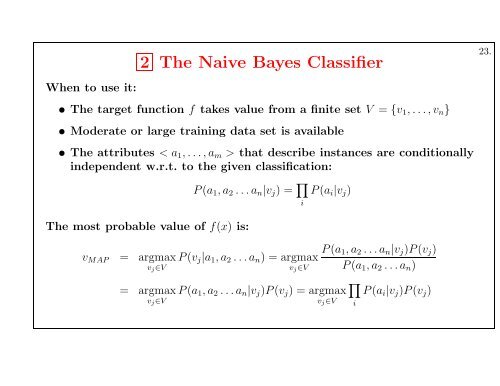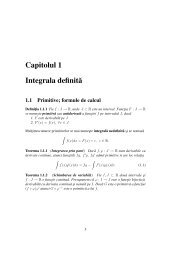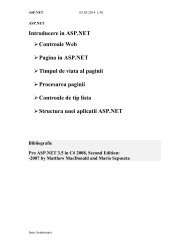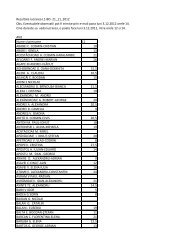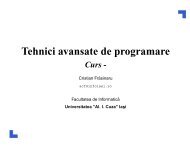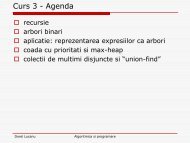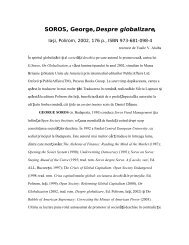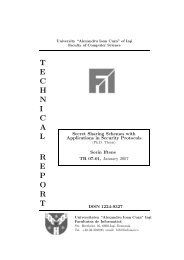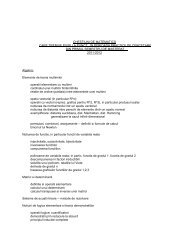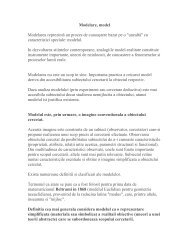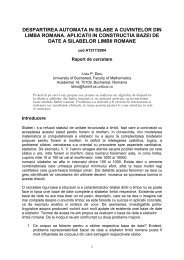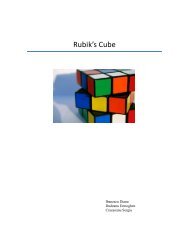2 The Naive Bayes Classifier - Profs.info.uaic.ro
2 The Naive Bayes Classifier - Profs.info.uaic.ro
2 The Naive Bayes Classifier - Profs.info.uaic.ro
Create successful ePaper yourself
Turn your PDF publications into a flip-book with our unique Google optimized e-Paper software.
When to use it:<br />
2 <st<strong>ro</strong>ng>The</st<strong>ro</strong>ng> <st<strong>ro</strong>ng>Naive</st<strong>ro</strong>ng> <st<strong>ro</strong>ng>Bayes</st<strong>ro</strong>ng> <st<strong>ro</strong>ng>Classifier</st<strong>ro</strong>ng><br />
• <st<strong>ro</strong>ng>The</st<strong>ro</strong>ng> target function f takes value f<strong>ro</strong>m a finite set V = {v1, . . . , vn}<br />
• Moderate or large training data set is available<br />
• <st<strong>ro</strong>ng>The</st<strong>ro</strong>ng> attributes < a1, . . . , am > that describe instances are conditionally<br />
independent w.r.t. to the given classification:<br />
<st<strong>ro</strong>ng>The</st<strong>ro</strong>ng> most p<strong>ro</strong>bable value of f(x) is:<br />
vMAP = argmax<br />
vj∈V<br />
= argmax<br />
vj∈V<br />
P (a1, a2 . . . an|vj) = �<br />
P (vj|a1, a2 . . . an) = argmax<br />
vj∈V<br />
i<br />
P (ai|vj)<br />
P (a1, a2 . . . an|vj)P (vj) = argmax<br />
vj∈V<br />
P (a1, a2 . . . an|vj)P (vj)<br />
P (a1, a2 . . . an)<br />
�<br />
i<br />
P (ai|vj)P (vj)<br />
23.
<st<strong>ro</strong>ng>The</st<strong>ro</strong>ng> <st<strong>ro</strong>ng>Naive</st<strong>ro</strong>ng> <st<strong>ro</strong>ng>Bayes</st<strong>ro</strong>ng> <st<strong>ro</strong>ng>Classifier</st<strong>ro</strong>ng>: Remarks<br />
1. Along with decision trees, neural networks, k-nearest neighbours,<br />
the <st<strong>ro</strong>ng>Naive</st<strong>ro</strong>ng> <st<strong>ro</strong>ng>Bayes</st<strong>ro</strong>ng> <st<strong>ro</strong>ng>Classifier</st<strong>ro</strong>ng> is one of the most practical<br />
learning methods.<br />
2. Compared to the previously presented learning algorithms,<br />
the <st<strong>ro</strong>ng>Naive</st<strong>ro</strong>ng> <st<strong>ro</strong>ng>Bayes</st<strong>ro</strong>ng> <st<strong>ro</strong>ng>Classifier</st<strong>ro</strong>ng> does no search th<strong>ro</strong>ugh the hypothesis<br />
space;<br />
the output hypothesis is simply formed by estimating the<br />
parameters P (vj), P (ai|vj).<br />
24.
<st<strong>ro</strong>ng>The</st<strong>ro</strong>ng> <st<strong>ro</strong>ng>Naive</st<strong>ro</strong>ng> <st<strong>ro</strong>ng>Bayes</st<strong>ro</strong>ng> Classification Algorithm<br />
<st<strong>ro</strong>ng>Naive</st<strong>ro</strong>ng> <st<strong>ro</strong>ng>Bayes</st<strong>ro</strong>ng> Learn(examples)<br />
for each target value vj<br />
ˆP (vj) ← estimate P (vj)<br />
for each attribute value ai of each attribute a<br />
ˆP (ai|vj) ← estimate P (ai|vj)<br />
Classify New Instance(x)<br />
vNB = argmax vj∈V ˆ P (vj) �<br />
ai∈x ˆ P (ai|vj)<br />
25.
<st<strong>ro</strong>ng>The</st<strong>ro</strong>ng> <st<strong>ro</strong>ng>Naive</st<strong>ro</strong>ng> <st<strong>ro</strong>ng>Bayes</st<strong>ro</strong>ng>: An Example<br />
Consider again the PlayTennis example, and new instance<br />
We compute:<br />
〈Outlook = sun, T emp = cool, Humidity = high, W ind = st<strong>ro</strong>ng〉<br />
vNB = argmax vj∈V P (vj) �<br />
i P (ai|vj)<br />
P (yes) = 9<br />
14<br />
. . .<br />
P (st<strong>ro</strong>ng|yes) = 3<br />
9<br />
= 0.64 P (no) = 5<br />
14<br />
= 0.36<br />
= 0.33 P (st<strong>ro</strong>ng|no) = 3<br />
5<br />
= 0.60<br />
P (yes) P (sun|yes) P (cool|yes) P (high|yes) P (st<strong>ro</strong>ng|yes) = 0.0053<br />
P (no) P (sun|no) P (cool|no) P (high|no) P (st<strong>ro</strong>ng|no) = 0.0206<br />
→ vNB = no<br />
26.
A Note on <st<strong>ro</strong>ng>The</st<strong>ro</strong>ng> Conditional Independence<br />
Assumption of Attributes<br />
P (a1, a2 . . . an|vj) = �<br />
i<br />
P (ai|vj)<br />
It is often violated in practice ...but it works surprisingly well<br />
anyway.<br />
Note that we don’t need estimated posteriors ˆ P (vj|x) to be<br />
correct; we need only that<br />
argmax<br />
vj∈V<br />
ˆP (vj) �<br />
i<br />
ˆP (ai|vj) = argmax<br />
vj∈V<br />
P (vj)P (a1 . . . , an|vj)<br />
[Domingos & Pazzani, 1996] analyses this phenomenon.<br />
27.
<st<strong>ro</strong>ng>Naive</st<strong>ro</strong>ng> <st<strong>ro</strong>ng>Bayes</st<strong>ro</strong>ng> Classification:<br />
<st<strong>ro</strong>ng>The</st<strong>ro</strong>ng> p<strong>ro</strong>blem of unseen data<br />
What if none of the training instances with target value vj have the attribute<br />
value ai?<br />
It follows that ˆ P (ai|vj) = 0, and ˆ P (vj) �<br />
i ˆ P (ai|vj) = 0<br />
<st<strong>ro</strong>ng>The</st<strong>ro</strong>ng> typical solution is to (re)define P (ai|vj), for each value vj of ai:<br />
ˆP (ai|vj) ← nc+mp<br />
n+m<br />
, where<br />
• n is number of training examples for which v = vj,<br />
• nc number of examples for which v = vj and a = ai<br />
• p is a prior estimate for ˆ P (ai|vj)<br />
(for instance, if the attribute a has k values, then p = 1<br />
k )<br />
• m is a weight given to that prior estimate<br />
(i.e. number of “virtual” examples)<br />
28.
Learning to Classify Text<br />
Using the <st<strong>ro</strong>ng>Naive</st<strong>ro</strong>ng> <st<strong>ro</strong>ng>Bayes</st<strong>ro</strong>ng> Learner<br />
• Learn which news articles are of interest<br />
Target concept Interesting? : Document → {+, −}<br />
• Learn to classify web pages by topic<br />
Target concept Category : Document → {c1, . . . , cn}<br />
<st<strong>ro</strong>ng>Naive</st<strong>ro</strong>ng> <st<strong>ro</strong>ng>Bayes</st<strong>ro</strong>ng> is among most effective algorithms<br />
29.
Learning to Classify Text: Main Design Issues<br />
1. Represent each document by a vector of words<br />
• one attribute per word position in document<br />
2. Learning:<br />
• use training examples to estimate P (+), P (−), P (doc|+), P (doc|−)<br />
• <st<strong>ro</strong>ng>Naive</st<strong>ro</strong>ng> <st<strong>ro</strong>ng>Bayes</st<strong>ro</strong>ng> conditional independence assumption:<br />
P (doc|vj) =<br />
length(doc)<br />
�<br />
i=1<br />
P (ai = wk|vj)<br />
where P (ai = wk|vj) is p<strong>ro</strong>bability that word in position i is wk, given vj<br />
• Make one more assumption:<br />
∀i, m P (ai = wk|vj) = P (am = wk|vj) = P (wk|vj)<br />
i.e. attributes are (not only indep. but) also identically distributed<br />
30.
Learn naive <st<strong>ro</strong>ng>Bayes</st<strong>ro</strong>ng> text(Examples, V )<br />
1. Collect all words and other tokens that occur in Examples<br />
V ocabulary ← all distinct words and other tokens in Examples<br />
2. Calculate the required P (vj) and P (wk|vj) p<strong>ro</strong>bability terms<br />
For each target value vj in V<br />
docsj ← the subset of Examples for which the target value is vj<br />
P (vj) ← |docsj|<br />
|Examples|<br />
T extj ← a single doc. created by concat. all members of docsj<br />
n ← the total number of words in T extj<br />
For each word wk in V ocabulary<br />
nk ← the number of times word wk occurs in T extj<br />
P (wk|vj) ←<br />
nk+1<br />
n+|V ocabulary|<br />
(here we use the m-estimate)<br />
31.
Classify naive <st<strong>ro</strong>ng>Bayes</st<strong>ro</strong>ng> text(Doc)<br />
positions ← all word positions in Doc that contain tokens f<strong>ro</strong>m V ocabulary<br />
Return vNB = argmax vj∈V P (vj) �<br />
i∈positions P (wk|vj)<br />
32.
Learning to Classify Usenet News Articles<br />
Given 1000 training documents f<strong>ro</strong>m each of the 20 newsg<strong>ro</strong>ups, learn to<br />
classify new documents according to which newsg<strong>ro</strong>up it came f<strong>ro</strong>m<br />
comp.graphics misc.forsale<br />
comp.os.ms-windows.misc rec.autos<br />
comp.sys.ibm.pc.hardware rec.motorcycles<br />
comp.sys.mac.hardware rec.sport.baseball<br />
comp.windows.x rec.sport.hockey<br />
alt.atheism sci.space<br />
soc.religion.christian sci.crypt<br />
talk.religion.misc sci.elect<strong>ro</strong>nics<br />
talk.politics.mideast sci.med<br />
talk.politics.misc<br />
talk.politics.guns<br />
<st<strong>ro</strong>ng>Naive</st<strong>ro</strong>ng> <st<strong>ro</strong>ng>Bayes</st<strong>ro</strong>ng>: 89% classification accuracy (having used 2/3 of each g<strong>ro</strong>up<br />
for training; eliminated rare words, and the 100 most freq. words)<br />
33.
100<br />
Learning Curve for 20 Newsg<strong>ro</strong>ups<br />
90<br />
80<br />
70<br />
60<br />
50<br />
40<br />
30<br />
20<br />
10<br />
0<br />
20News<br />
<st<strong>ro</strong>ng>Bayes</st<strong>ro</strong>ng><br />
TFIDF<br />
PRTFIDF<br />
100 1000 10000<br />
Accuracy vs. Training set size<br />
34.


